Railroads In The Postwar (1950s): Facts, Statistics, Photos
Last revised: October 27, 2024
By: Adam Burns
The post-World War II railroad industry, through the 1950s, was a fascinating dichotomy of initial prosperity followed by increasing struggle and frustration. The new decade dawned with great hope for not only continued strong freight tonnage but also a belief that rail travel would continue to prosper.
The streamliner craze, so prevalent during the 1930s, had slowed considerably by the postwar era, although trains remained the preferred method of long distance (and commuter) travel.
Several lines, like the Pennsylvania and New York Central, spent lavishly on new passenger equipment (and advertising efforts) while much of the industry used their wartime profits to finish the transition from steam to diesel.
After the war, one of the first tasks of many railroads was to retire their iconic steam locomotives as quickly as possible. While there were holdouts, such as the Norfolk & Western and Chesapeake & Ohio, most systems were sold on Electro-Motive's FT of 1939 and acquired new diesels from all of the major manufacturers after the war through the late 1950s.
From a macro view, the 1950s were a struggle; aside from declining passenger business, a recession and improved highways (including signage of the Interstate Highway Act) heavily eroded the industry's traffic base.
The situation would not improve until the Staggers Act was signed into law by President Jimmy Carter on October 14, 1980, which enabled railroads more freedom to set freight rates and abandon or sell unprofitable corridors.
Photos
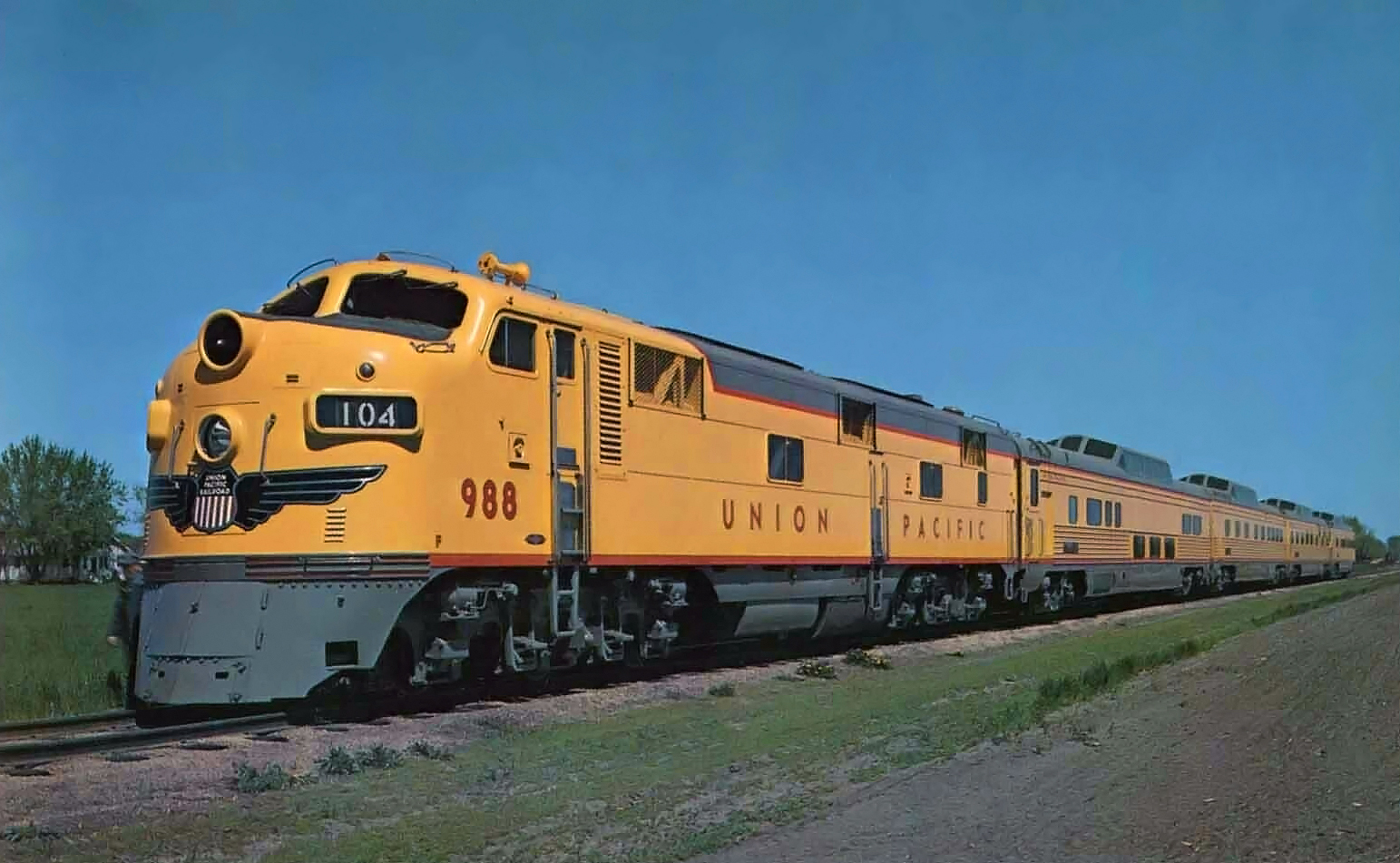 A Union Pacific publicity photo featuring the "Train of Tomorrow" in the spring of 1950. It was heralded as the future in rail travel and featured all of the latest luxuries.
A Union Pacific publicity photo featuring the "Train of Tomorrow" in the spring of 1950. It was heralded as the future in rail travel and featured all of the latest luxuries.History
As World War II wound down, the War Production Board eased restrictions on diesel locomotive development and manufacturing. As a result, railroads accelerated their efforts to complete dieselization. In addition, the prospect of postwar prosperity along with continued strong freight and passenger traffic, gave the industry confidence this would continue into the 1950s.
The New York Central and Pennsylvania - both among the nation's most profitable and respected railroads - were so confident, in fact, they placed large orders for new lightweight passenger equipment from all of the major car manufacturers. This sentiment was felt by many other lines.
In their book, "The Cars Of Pullman," authors Joe Welsh, Bill Howes, and Kevin Holland point out the industry purchased 4,400 lightweight passenger cars during the 1950s, at a total cost of $1.3 billion in an effort to keep the public traveling by train.
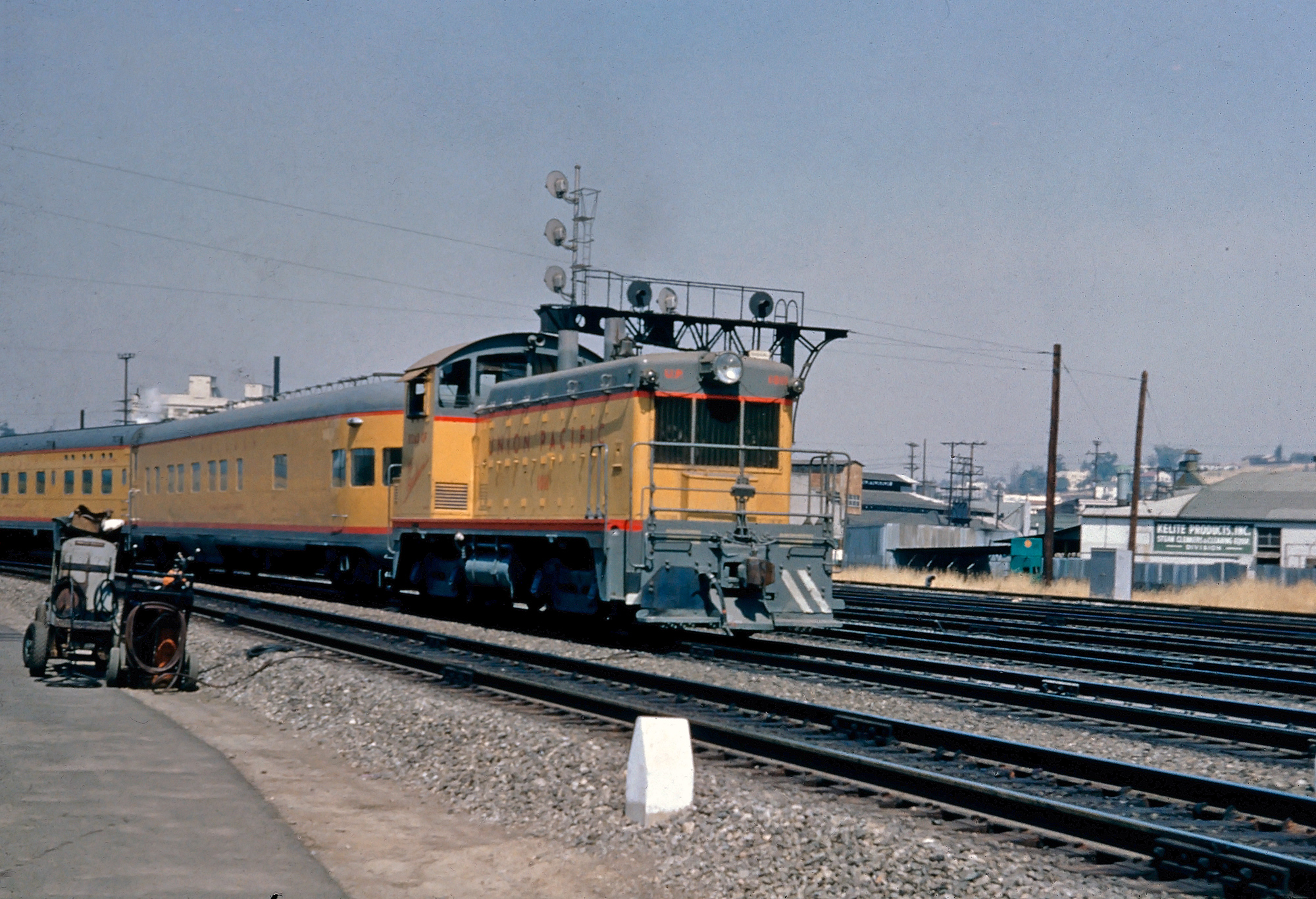 Union Pacific NW2 #1011 switches streamlined equipment of the "City" fleet in Los Angeles on June 6, 1954. American-Rails.com collection.
Union Pacific NW2 #1011 switches streamlined equipment of the "City" fleet in Los Angeles on June 6, 1954. American-Rails.com collection.New Streamlined Trains
In their December 15, 1945 issue, Railway Age highlighted New York Central's massive order of 721 new passenger cars, which had cost $56 million. It was the largest single order of such car in the industry's history and reequipped a total of 52 trains.
The cars included 239 from the Budd Company, 354 from Pullman-Standard, and 128 from American Car & Foundry. The Pennsylvania made an announcement at the same time, stating it too was placing a larger order for new equipment to the tune of $21 million for 214 new cars from the big three manufacturers.
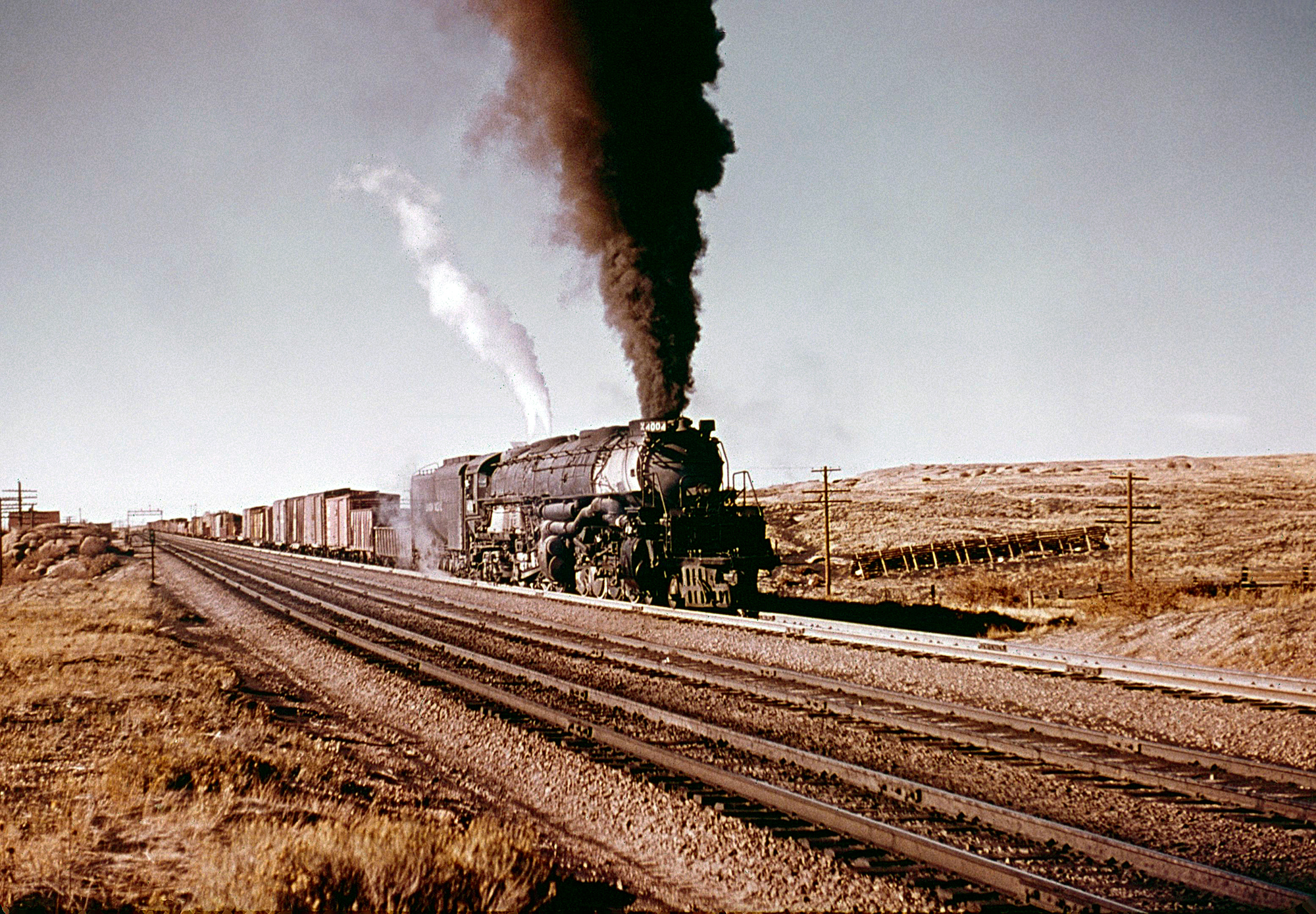 Union Pacific 4-8-8-4 #4004 charges through rural Hermosa, Wyoming with an eastbound manifest on October 16, 1955. Bob Collins photo. American-Rails.com collection.
Union Pacific 4-8-8-4 #4004 charges through rural Hermosa, Wyoming with an eastbound manifest on October 16, 1955. Bob Collins photo. American-Rails.com collection.Rail Travel Decline
When President Dwight Eisenhower signed the Federal-Aid Highway Act into law on June 29, 1956 (also known as the National Interstate and Defense Highways Act), the fate of trains as the primary means of interstate travel was all but sealed. The act provided funding for a 40,000-mile system of four-lane highways linking every state in the continental U.S. in both east-to-west and north-to-south configurations.
The interstates offered the public complete freedom to travel between large cities whenever they wished, and usually faster than by train. Before the automobile's debut railroads owned almost 100% of passenger traffic but by 1957 held just 31.4%. A few stats regarding the passenger train's decline during these years:
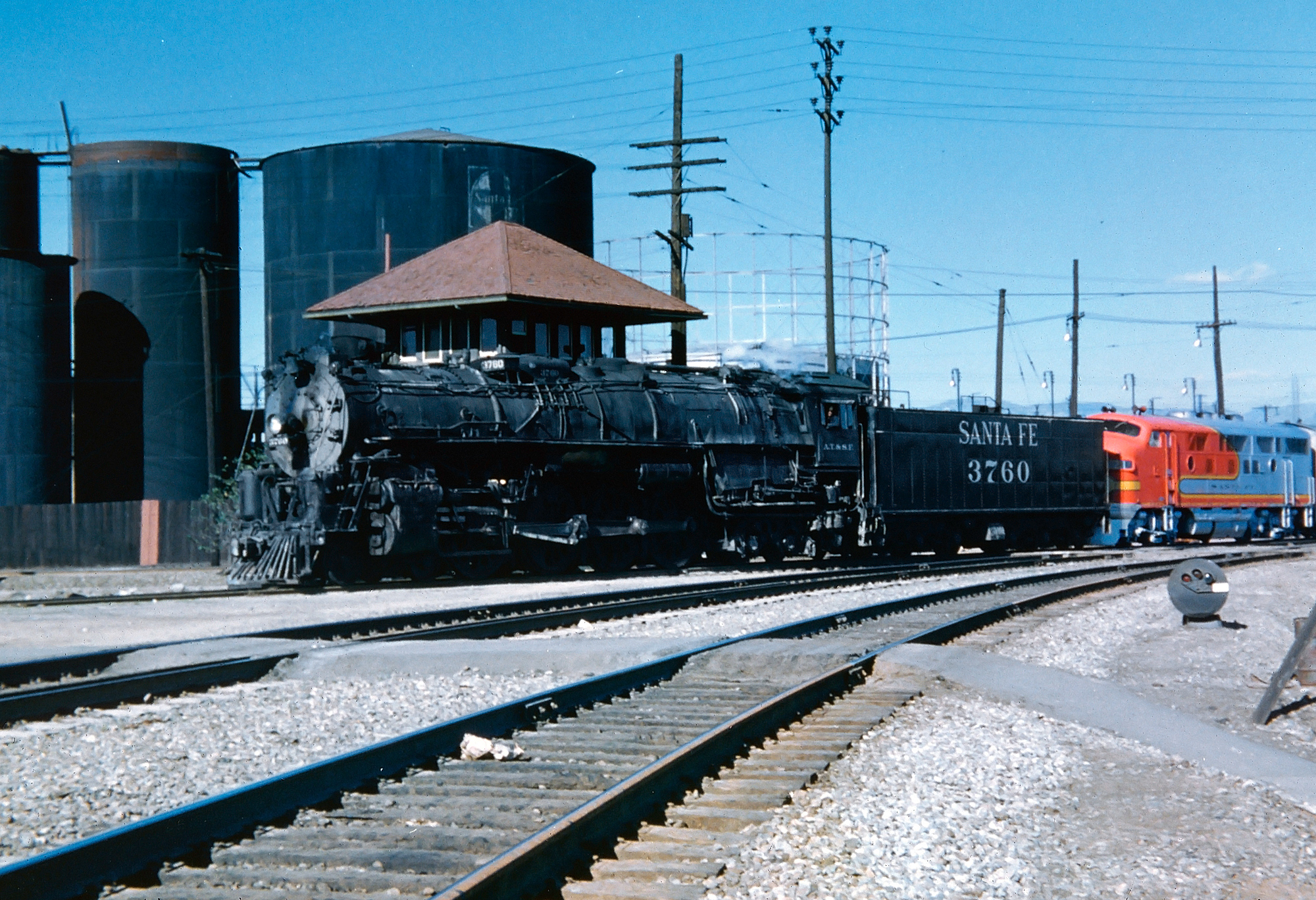 Santa Fe 4-8-4 #3760 and F3A #21-L are southbound as they pass the interlocking tower at Redondo Junction (Los Angeles) in July, 1950. American-Rails.com collection.
Santa Fe 4-8-4 #3760 and F3A #21-L are southbound as they pass the interlocking tower at Redondo Junction (Los Angeles) in July, 1950. American-Rails.com collection.At A Glance
223,779 Miles (1950) 211,459 Miles (1955) | |
1,519 Miles Peak Year (1916): 15,580 Miles | |
Net Income (1957): $46 million (Down 39% since 1955) Working Capital: $576 million (1957), $880 million (1955) 410,022 Weekly Carloads: Late December, 1957 (Lowest point since December, 1932.) | |
770 million (1946) 298 million (1964) | |
2,500+ (1955) 500 (1968) |
Sources (Above Table):
- Boyd, Jim. American Freight Train, The. Osceola: MBI Publishing, 2001.
- Del Vecchio, Mike. Railroads Across America. Osceola: MBI Publishing, 1998.
- Hilton, George and Due, John. Electric Interurban Railways in America, The. Stanford: Stanford University Press, 2000.
- McCready, Albert L. and Sagle, Lawrence W. (American Heritage). Railroads In The Days Of Steam. Mahwah: Troll Associates, 1960.
- Stover, John. Routledge Historical Atlas of the American Railroads, The. New York: Routledge, 1999.
- Schneider, Gregory L. Rock Island Requiem: The Collapse Of A Mighty Fine Line. Lawrence: University Press Of Kansas, 2013.
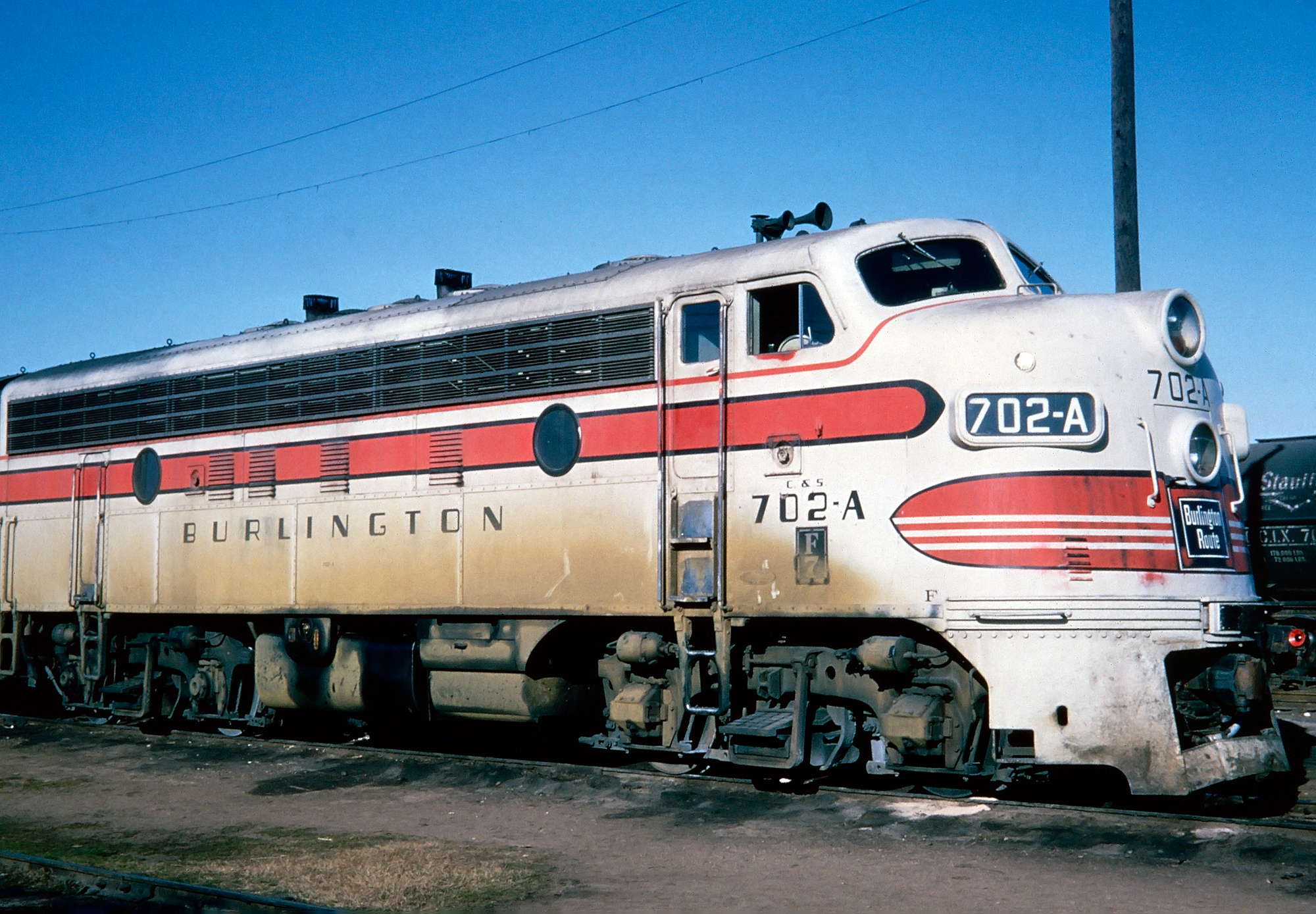 A handsome Colorado & Southern (Burlington) F7A, #702-A, although a bit dirty, lays over in Denver, Colorado during the early 1960s. American-Rails.com collection.
A handsome Colorado & Southern (Burlington) F7A, #702-A, although a bit dirty, lays over in Denver, Colorado during the early 1960s. American-Rails.com collection.The Train Of Tomorrow
Heralded by Electro-Motive and Pullman as the future in rail travel the Train of Tomorrow boasted all of the latest luxuries. The train was originally adorned in a two-tone blue livery by General Motors, which was quickly replaced by UP.
Up front, in the photo above, was E7A #988. It was followed by four "Astra Domes" in various configurations:
- Chair car Star Dust
- Coach-diner Sky View
- 3-compartment/2 drawing room/8 duplex-roomette sleeper-lounge Dream Cloud
- Club-Lounge observation Moon Glow
The train was showcased at the Chicago Railroad Fair during the summer's of 1947 and 1948 before UP's acquisition of the set, initially placing it on tour between Portland and Seattle in 1950 (ironically with no name). Its perks (among others) included Hyatt roller-bearing journals on all trucks (each equipped with its own power system), chilled water (powered by Frigidaire), frozen or cooled food, and of course air-conditioning.
Even prior to the Federal-Aid Highway Act, rail travel was waning. In his book, "Pennsylvania Railroad's Broadway Limited" author Joe Welsh notes the PRR lost an incredible $71 million in 1951 in passenger operations. Still, the industry did not give up completely on the service.
The dome car, unveiled by the Budd Company and Burlington in June, 1945 with the Vista-Dome Silver Dome (formerly coach Silver Alchemy), brought renewed hope the public could once again be lured back to the rails. Only two years later, General Motors debuted its Train Of Tomorrow in the spring of 1947, a four-car, all dome train (led by an E7A).
There were many variations of these cars built throughout the 1950s; names like Astra-Dome, Santa Fe's Hi-Levels, Great Dome, Super Dome, Strata-Dome, and of course the previously mentioned Vista-Dome. The cars' upper-level afforded passengers breathtaking views of the surrounding landscape and did work, to a degree, in bringing back the public.
Interestingly, Union Pacific continued to reequip its trains with domes until 1958 when the final five were acquired from Pullman-Standard, numbered 7011-7015, for the City of St. Louis.
Despite the growing passenger losses, railroads did have some notable gains. For instance, ton-mileage per worker had doubled every fifteen years since the end of World War I. Also, the 1950s saw TOFC, or trailer-on-flat-car (better known as piggyback since the trailers road atop a specialized flatcar), greatly expand as railroads attempted to combat the growing threat of trucks.
This service allowed railroads to haul unit trains of truck trailers, an extremely efficient and beneficial arrangement to both industries, and remains a lucrative service today.
In his book, "The American Freight Train," author Jim Boyd notes railroads began experimenting with highway trailers on flatcars as early as the 1920s while Mike Schafer points out in "More Classic American Railroads" that Chicago Great Western, one of the great industrial pioneers, began regularly offering TOFC service as early as 1936.
Ironically, the very first railroad to ever test the trailer-on-flatcar concept was actually an interurban, the Chicago, North Shore & Milwaukee. The classic North Shore Line was predominantly focused on serving the public by providing high speed, rapid transit service between Chicago and Milwaukee. However, the system also operated a rather substantial carload freight business.
To help combat the growing competition from trucks, which were rapidly eating away at less-than-carload, or LCL, business, the North Shore Line began testing piggyback service in 1926. Some of the more notable TOFC concepts included New York Central's "Flexi Van" service of 1957 and Pennsylvania's TrucTrain concept of 1954.
While the PRR's idea was essentially the modern piggyback service - it even launched a company in March, 1956 still very well known today, the TrailerTrain Company (TTX), which maintains its own fleet of specialized flatcars - the "Flexi Van" was a bit more innovative.
It was essentially a combination truck trailer/shipping container which were carried on their own specialized flatcars. Both concepts were deemed a success although the "Flexi Van" fell out of favor as the industry focused on handling truck trailers directly.
By 1959 there were 50 railroads experimenting or utilizing TOFC service and by the following decade it was a fairly common practice. In fact, many railroads began adding one, or more, expedited piggyback cars onto some of their secondary passenger trains to offset the growing losses of these services.
One of other improvements was in the area of physical plant maintenance as machines increasingly replaced manual track gangs. This equipment was not only cheaper to operate but also allowed the work to be performed much faster.
These track upgrades allowed for faster and heavier trains, and more than half of all lines in operation by late the 1950s featured track of 100 pounds or greater. Finally, Centralized Traffic Control (CTC) and data processing also greatly reduced operating costs.
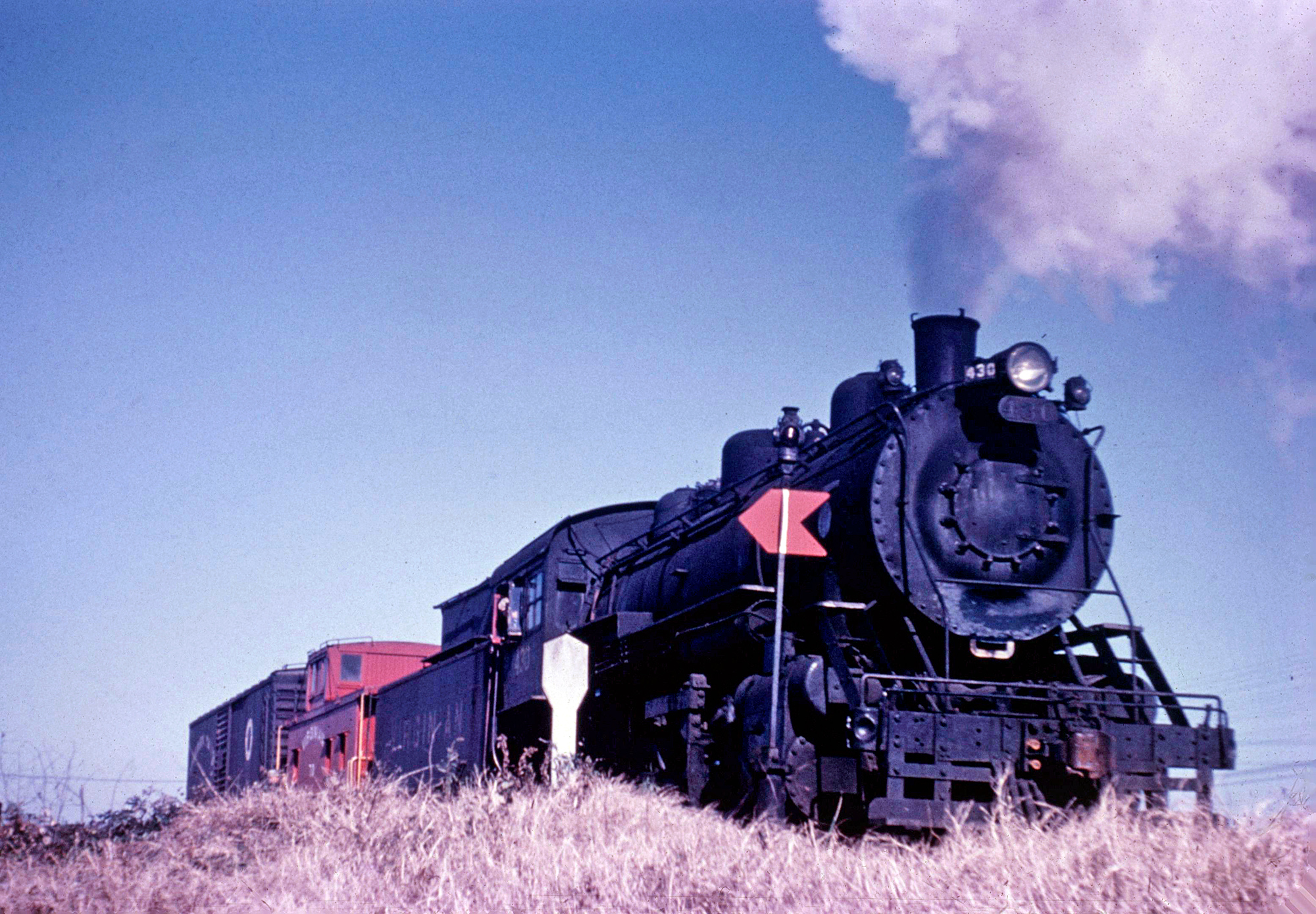 Virginian Railway 2-8-2 #430 (Class MB) carries out switching chores in Norfolk, Virginia during December of 1954. These Mikados could often be found in the Tidewater area at work. H. Reid photo. American-Rails.com collection.
Virginian Railway 2-8-2 #430 (Class MB) carries out switching chores in Norfolk, Virginia during December of 1954. These Mikados could often be found in the Tidewater area at work. H. Reid photo. American-Rails.com collection.Market Share Losses
By late in the decade, however, things were looking increasingly grim. Author H. Roger Grant, in his book, "Erie Lackawanna: Death Of An American Railroad, 1938-1992," notes railroads' share of intercity freight traffic dropped from precipitously from 68% in 1944 to just 44% in 1960. In addition, its intercity passenger traffic during the same period further declined from 74% to a staggering 27%.
With less money available, several railroads were forced to reduce investment in their physical plants, as well as general maintenance. The number of bad order freight cars, or those out of service for overhaul, nearly doubled between 1956 and 1958.
This was especially an issue on eastern railroads where freight hauls were generally less profitable due to their shorter distance between termination points in comparison to western systems. For instance, while the Pennsylvania's bad order cars jumped from 7.4% in January, 1957 to 11.2% the next year, Southern Pacific's stood only at 2% as of January, 1958.
To combat the rising costs and tightening monetary situation, many railroads looked to merger. It began with the Norfolk & Western's acquisition of the smaller Virginian Railway in 1959. Ironically, the N&W's takeover was largely a move to remove the competition as the Roanoke-based system was very healthy thanks to the prodigious coal tonnage it handled annually.
There were others, however. The Delaware, Lackawanna & Western and Erie were in serious talks to merge by the late 1950s. In addition, Union Pacific and Rock Island were also in the process of joining by the early 1960s while the Milwaukee Road and Chicago & North Western were in discussion of coming together as early as late 1954.
Perhaps the greatest indicator of something amiss industry-wide was at the Pennsylvania Railroad. It lost money for the first time in its history in 1946 and began the unthinkable discussions of merging with longtime rival New York Central in 1957.
There was also the case of the New York, Ontario & Western. This classic Northeastern carrier was the weakest of several serving the state of New York. It was destitute by the 1950s. As the trustees realized the company's future appeared doomed they made one last attempt to keep segments operating by having interested parties purchase various routes.
Unfortunately, the talks dragged out and creditors grew increasingly impatient to sell off the assets and recover their losses. Realizing the unrest, the bankruptcy court ordered the O&W liquidated and its assets sold on March 29, 1957. It was the largest liquidation of its day until the Rock Island met a similar fate in 1980.
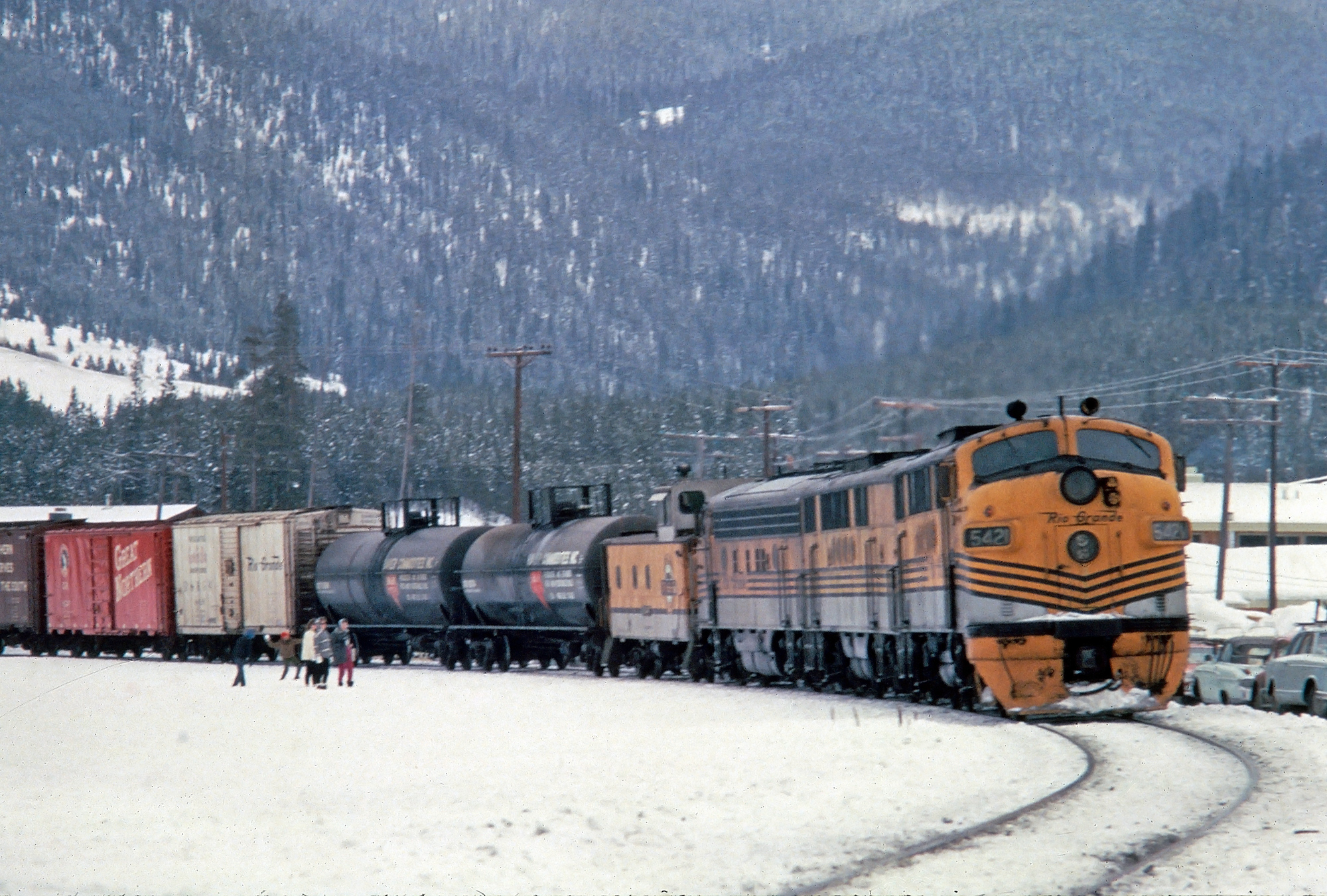 A Rio Grande A-B set of FT's, along with an F7A, shove on an eastbound freight at Winter Park, Colorado during the 1960s. Out of view at left is the west portal of Moffat Tunnel. American-Rails.com collection.
A Rio Grande A-B set of FT's, along with an F7A, shove on an eastbound freight at Winter Park, Colorado during the 1960s. Out of view at left is the west portal of Moffat Tunnel. American-Rails.com collection.Two other notable events hurt railroads during the 1950s; the costs for both labor and materials were rising as a result of wage increases and inflation. In his book, "Rock Island Requiem: The Collapse Of A Mighty Fine Line," author Greg Schneider notes the cost for general physical plant items like ties, ballast, and rail jumped by 40% between 1948 - 1957.
In addition, a national recession, which commenced in the last quarter of 1957, resulted in the gross domestic product dropping by 3.7%. Everything from automobiles to agriculture saw lower sales causing fewer carloads industry-wide; revenue declined by 39% between 1955-1957. Similarly, working capital dropped sharply during this same period from $880 million to $576 million.
The situation was becoming so precarious that the Senate Subcommittee for Surface Transportation held meetings in Washington, D.C. on January 17, 1958 to address the problem. More than twenty railroad executives were present.
As Senator George Smathers (D-Florida) noted, "There is little question that today our railroads are in serious condition. A mighty industry has come upon sick and precarious times." Despite this concern, Congress would do little to help and the industry continued its slide into the 1960s...
Additional Sources
- Doughty, Geoffrey H. New York Central's Great Steel Fleet, 1948-1967 (Revised Edition). Lynchburg: TLC Publishing, Inc., 1999.
- Grant, Roger H. Erie Lackawanna: Death Of An American Railroad, 1938-1992. Stanford: Stanford University Press, 1994.
- Murray, Tom. Milwaukee Road, The. St. Paul: MBI Publishing, 2005.
- Schafer, Mike. More Classic American Railroads. Osceola: MBI Publishing, 2000.
- Schafer, Mike and Solomon, Brian. Pennsylvania Railroad. Osceola: MBI Publishing, 1997.
- Schneider, Gregory L. Rock Island Requiem: The Collapse Of A Mighty Fine Line. Lawrence: University Press Of Kansas, 2013.
- Solomon, Brian and Schafer, Mike. New York Central Railroad. St. Paul: Andover Junction Publications, 2007.
- Welsh, Joe: Holland, Kevin: and Howes, Bill. Cars Of Pullman, The. Minneapolis: Voyageur Press, 2010.
- Welsh, Joe. Pennsylvania Railroad's Broadway Limited. St. Paul: MBI Publishing, LLC, 2006.
Recent Articles
-
Ferrocarriles Nacionales de México (N de M)
Jan 04, 26 11:52 PM
For much of the twentieth century, Ferrocarriles Nacionales de México—better known by its classic initials N de M, and later as FNM/Ferronales—served the heart of Mexico. -
Missouri Dinner Train Rides In Branson!
Jan 04, 26 07:00 PM
Nestled in the heart of the Ozarks, the Branson Scenic Railway offers one of the most distinctive rail experiences in the Midwest—pairing classic passenger railroading with sweeping mountain scenery a… -
Indiana Dinner Train Rides In Jasper
Jan 04, 26 06:32 PM
In the rolling hills of southern Indiana, the Spirit of Jasper offers one of those rare attractions that feels equal parts throwback and treat-yourself night out: a classic excursion train paired with…



